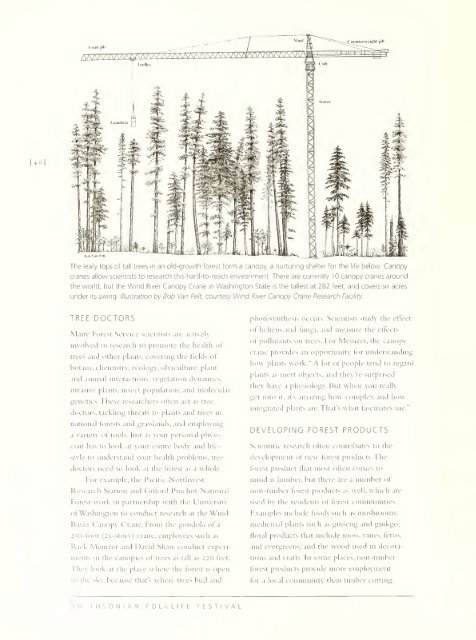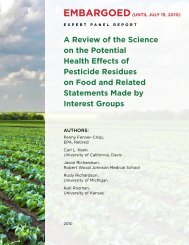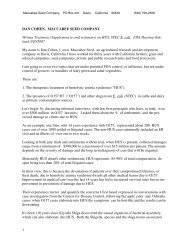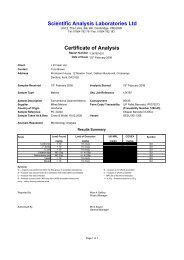--^i'liunterw eight jihI ...itl jibAAAAAAAAAAAAAAÁÁAAAAAAyWVWWX,[40]The leafy tops of tall trees in an old-growth forest form a canopy, a nurturing shelter for the life below Canopycranes allow scientists to research this hard-to-reach environment. There are currently 10 canopy cranes aroundthe world, but the Wind River Canopy Crane in Washington State is the tallest at 282 feet, and covers six acresunder its swing. Illustration by Bob Van Pelt, courtesy Wind River Canopy Crane Research FacilityTREE DOCTORSMany Forest Service scientists arc ac tivcbinvolved in research to promote the health oítrees and other plants, covering the fields ofbotany, chemistry, ecology, silviculture, plantand animal interactions, vegetation dynamics,invasive plants, insect population, and moleculargenetics These researchers often act as treedoctors, tackling threats to plants and trees innational forests and grasslands, and employinga variety of tools. |ust as your personal physi-( 1 .1 1 1 has to look at your entire body and lifestyleto understand your health problems, treedoctors need to look at the forest as a whole.For example, the Pacific NorthwestResearch Station and GifFord Pinchot NationalI orest work 111 partnership with the Universityof Washington to conduct research at the WindRiver Canopy Crane. From the gondola of a250-toot (25-story) crane, employees such asKick Meinzer and David Shaw conduct experiments111 the canopies ot trees as tall as 220 feet.They look at the place where the forest is opento the sky, because that's where trees bud andphotosynthesis occurs. Scientists study the effectot lichens and fungi, and measure the effectsof pollutants on trees. For Meinzer, the canopycrane provides an opportunity for understandinghow plants work. "A lot ot people tend to regardplants as inert objects, and they're surprisedthey have aphysiology. But when you reallyget into it. it's amazing how complex and howintegrated plants are. That's what fascinates me."DEVELOPING FOREST PRODUCTSScientific research often contributes to thedevelopment ot new forest products. Theforest product that most often comes tomind is lumber, but there are a number otnon-timber forest products as well, winch areused by the residents ot forest communities.Examples include foods such as mushrooms;medicinal plants such as ginseng and ginkgo:floral products that include moss, vines, ferns,and evergreens; and the wood used in decorationsand crafts. In some places, non-timberforestproducts provide more employmenttor a local community than timber cutting.SMITHSONIAN FOLKLIFE FESTIVAL
Overgrown, a dense forest can burn likematchsticks in a wildfire, but it can be thinned,and the thinned materials can be used forawinery ot products. The Forest ProductsLaboratory, established in iyio in Madison,Wisconsin, is the nation's leading woodresearch institute, studying various aspects ofpaper making, wood preservation, and recycling.Their research has helped increase theaverage lumber yield per log from 25 percentto 60 percent, extended the life of railroad ties,and developed protocols for the U.S. PostalService to make no-lick stamps recyclable.PRESERVING OUR HERITAGEWhile many Forest Service researchers arelooking to the future, another section ot theagency's workforce is actively involved inpreserving the past and connecting people'shistory to the land. As described by the ForestService's National Heritage Strategy, "Waitingsilently in the mountains, canyons, and rivervalleys of our national forests and grasslandsare the remnants of past cultures that confrontus and remind us of the centuries-old relationshipbetween people and the land. TheseENFORCING THE LAWThe Forest Service Law Enforcement andInvestigations (LEI) staff has the overall job ofupholding the laws and regulations that protectnatural resources. Law enforcement personnelprotect natural resources, people, and property,often working in partnership with local, state,and other federal law enforcement offices.As Berneice Anderson, a Regional PatrolCommander based in Milwaukee. Wisconsin,explains, "A lot ot people think that everyonewho visits the forest is out to have a very goodafternoon or weekend, enjoying the naturalresources and the scenery. And that's what wehope tor, but we also know that at any giventime we have to be prepared tor the thingsthat are negative." As a result, LEI officers maybe called upon to investigate crimes such astimber theft, arson, or the illegal cultivation ofmarijuana on national forest lands. They alsoprotect archaeological sites, investigate vehicleaccidents, provide first aid, educate the public,and assist in search and rescue operations.The duties of LEI officers can be lifethreatening. For this reason, Andy Coriell,Patrol Captain on Oregon's Mount Hoodheritage resources hold clues to past ecosystems,add richness and depth to our landscapes,provide links to living traditions, and helptransform a beautiful walk 111the woods intoan unforgettable encounter with history."Empowered by the National HistoricPreservation Act ot 1996, archaeologists andother heritage specialists locate artifacts andhistorical sites in order to preserve and protectthem from road construction, prescribedburning, and vandalism. Artifacts that arelocated and protected include pottery, baskets,ancient tools, rock paintings and petroglvphs,and, in some cases, prehistoric dinosaur bones.Jeff Bryden and Flash, a Chesapeake Bay Retriever,make a great law enforcement team. Flash is thefirst dog in the Forest Service trained to detectcontraband fish and wildlife, instead of drugs.Flash can also track lost visitors.FOREST SERVICE, CULTURE, AND COMMUNITY
- Page 1: Smithsonianolklife Festival\Food Cu
- Page 4 and 5: The annual Smithsonian Folklite Fes
- Page 7 and 8: —CONTENTSThe Festival's Timely Ap
- Page 9 and 10: —THE FESTIVAL'S TIMELY APPEALLAWR
- Page 11 and 12: COMMERCE FOR CULTUREFrom the Festiv
- Page 13 and 14: [ii]The food concession for the Mel
- Page 15 and 16: oMiiitbioni.indotal SoundL04.A 1 Sl
- Page 17: 1WELCOME TO THE 2005 FOLKLIFE FESTI
- Page 20 and 21: Workers harvest artichokes at Ocean
- Page 22 and 23: —assigned aparticular dish—meat
- Page 24 and 25: I--IPot Pie Farm manager Elizabeth
- Page 26 and 27: ISustainable farmers such as Eliot
- Page 28 and 29: "IThe numberof programsdesignedfor
- Page 30 and 31: .hadSALAD GREENS WITH GOAT CHEESE,
- Page 32 and 33: w.A>wm:~
- Page 34 and 35: —3 3]OCCUPATIONAL CULTUREThe 2005
- Page 36 and 37: employees, the USDA Forest Servicei
- Page 38 and 39: I[3 6]page book, which could fit in
- Page 40 and 41: ká.!i- .>!mKPA backpacker sets up
- Page 44 and 45: —4-"The essentialpiece isto captu
- Page 46 and 47: I44cutDUTCH OVENONE-POT MEALThomas
- Page 48 and 49: —FUTURE CONCERNS FOR PUBLIC LANDS
- Page 50 and 51: NUESTRA MÚSICA: MUSIC INBuilding C
- Page 52 and 53: plena groups throughout the Northea
- Page 54 and 55: NUESTRA MÚSICA LAUNCHES NEW SERIES
- Page 56 and 57: NUESTRA MÚSICA: MUSIC IN LATINO CU
- Page 58 and 59: "ILos Camperos de Valles son músic
- Page 60 and 61: RAICES LATINASNUESTRA MÚSICA LANZA
- Page 63 and 64: IOMAN: DESERT, OASIS, AND SEARICHAR
- Page 65 and 66: DESERTThe deserts ot the Arabian Pe
- Page 67 and 68: THE FESTIVAL PROGRAMThe 200s Smiths
- Page 70 and 71: 6 8The coiled, leather-covered bask
- Page 72 and 73: 70]COASTAL CRAFTSMANSHIPAND GLOBAL
- Page 74 and 75: [72]Although the oldismaking way fo
- Page 76 and 77: AN OMANI FOLKTALEASYAH AL-BUALYOman
- Page 79 and 80: y%aMUSIC AND DANCE INOMANOMAN CENTR
- Page 81: In the southern Dhufar region, al-b
- Page 84 and 85: ecosystems, identification of plant
- Page 86 and 87: 2:00IIIVorkshopFESTIVAL SCHEDULE (P
- Page 88 and 89: Rhythm,Saturday, June 25 (Programs
- Page 90 and 91: )avidi nestMonday, June 27(Programs
- Page 92 and 93:
1:00IIlamFriday, July 1 (Programs a
- Page 94 and 95:
)utchSunday, July 3(Programs are su
- Page 96 and 97:
EVENING CONCERTSSounds of the Fores
- Page 98 and 99:
theRELATED EVENTS[96]Nuestra Músic
- Page 100 and 101:
IIDónalas Anderson,Washington, D.C
- Page 102 and 103:
'IEd LiíDmi, Studio City, Californ
- Page 104 and 105:
ISudhir Seth, Bethesda, MarylandA g
- Page 106 and 107:
1 if 1 DumberHoneyBeehive Beeproduc
- Page 108 and 109:
1"''NewI >onI Lui\IDon Bustos,Espa
- Page 110 and 111:
Ian Barlow, White Bird,Idaho; Woodl
- Page 112 and 113:
I 'istnet1Gordon Grant,Corvallis, O
- Page 114 and 115:
Kristen Marline, Flagstaff,Arizona;
- Page 116 and 117:
I1 ountries,IIHistorie Site, once t
- Page 118 and 119:
1IworksI1 11Istations are vital to
- Page 120 and 121:
1'IenIpanderetas;JCJ Band. Washingt
- Page 122 and 123:
Ralph Rinzlersongs are "made" (or c
- Page 124 and 125:
I >cmseI VhorahII MiI lameEne Nance
- Page 126 and 127:
|i 2forIIBartlevy1 )oerr;IIParadeSP
- Page 128 and 129:
II AerialIIII1Washington and Jeffer
- Page 130 and 131:
Stack, Bill Stafford, loni Stafford
- Page 132 and 133:
SMITHSONIAN FOLKLIFE FESTIVAL 20051
- Page 135 and 136:
SMITHSONIAN FOLKLIFE FESTIVAL 2005B
- Page 138:
Smithsonian Folklife FestivalSMITHS








